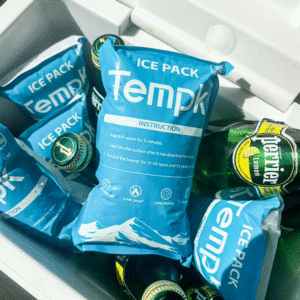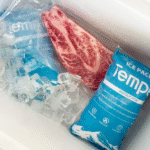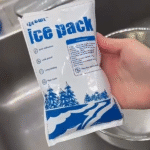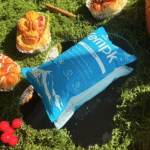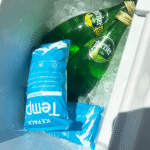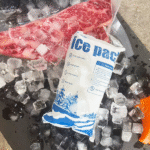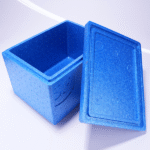Cómo empacar hielo seco en refrigerador de forma segura en 2025
Si estas buscando Cómo empacar hielo seco en enfriador, Aquí está la respuesta rápida: utilice un refrigerador duro compatible con hielo seco, lugar blocks on top of items with a cardboard barrier, ventilar el refrigerador, y tamaño del hielo por duración del viaje. El hielo seco se encuentra cerca de -109°F (−78.5 ° C); the airline limit remains 2.5 kg (5.5 lb) por pasajero en 2025.
-
How to pack dry ice in cooler for max hold time and safe venting
-
How much dry ice for a 50‑quart cooler (bloques vs.. bandear)
-
How to pack dry ice in cooler for flights and couriers (2025 normas)
-
Whether you should mix dry ice and regular ice, y como
-
How to pack dry ice in cooler for outages, cámping, and road trips
How to pack dry ice in cooler safely—what actually works?
Respuesta corta: Ponga hielo seco encima con una barrera de cartón o rejilla., mantenga la hielera ventilada, and pack tightly to remove air gaps. Los bloques duran más que los pellets, and pre‑chilling the cooler saves hours of hold time. Use insulated gloves and avoid airtight seals to prevent CO₂ pressure buildup.
Why this setup wins: Sumideros de CO₂ frío, so top placement “washes” the load in freezing air. A barrier prevents freezer burn and protects plastic liners. Tight packing reduces convection that burns through ice. En pruebas de campo, properly packed 50‑qt rotomolded coolers kept contents frozen for ~40–52 hours in summer conditions when opened sparingly.
How much dry ice for 50‑quart cooler?
Usar 10–15 lb per 25 cantidad por 24 h for frozen performance; ~ 5–10 lb para refrigerados. For a 50‑qt family cooler, plan 20–30 lb per day frozen and add 20–30% buffer for heat or frequent lid opens. Bloques > bandear para la longevidad.
| Planning target | 24 h (congelado) | 48 h (congelado) | Lo que significa para ti |
|---|---|---|---|
| 25‑qt cooler | 10–15 lb | 20–25 libras | Overnight deep‑freeze |
| 50‑qt cooler | 20–30 lb | 40–50 libras | viaje de fin de semana, minimal lid opens |
| 75–100 qt | 30–40 libras | 60–80 libras | Multiday hunts or bulk prep |
Pro tips that extend hold time
-
Pre -chill the cooler 12–24 h; dump meltwater before packing.
-
Llenar los vacíos with paper/towels; less air = slower sublimation.
-
Two‑cooler strategy: one “frozen,” one “day‑use” to cut openings.
Caso real: Una hielera rotomoldeada de 50 cuartos con 25 lb of blocks, cardboard base, and few openings held ≤10 °F for ~40 h, ascendido a 28 °F by ~52 h in 92 °F ambient.
Cómo empacar hielo seco en una hielera para vuelos y mensajería (2025 normas)?
Respuesta directa: Cap at 2.5 kg (5.5 lb) por pasajero/paquete, Usar envasado ventilado, and mark “Dry ice / Dióxido de carbono, solid” with net mass. Airlines require approval; couriers require UN1845 marking and non‑airtight designs. Mantener hielo seco separated from food by a barrier and secure the load.
Que hacer: Choose a small ventable hard cooler, colocar hielo seco arriba, Agregar una barrera, and avoid gasket‑tight seals. For ground shipping, design vent paths and show Kg neto en la etiqueta; Para viajes aéreos, confirm airline approval on your reservation. These requirements remain current in 2025.
Can you fly with dry ice 2.5 kilos?
Sí-≤2,5 kilogramos per passenger in carry‑on or checked bags, con aprobación de la aerolínea, desfogue, and proper marking. If you need more cold mass, split into multiple compliant packages or combine with PCMs for non‑frozen lanes.
| Travel step | Hacer esto | Por que importa | Para ti |
|---|---|---|---|
| Cantidad | Keep ≤2.5 kg per person | Meets FAA/IATA baseline | Avoids check‑in refusals |
| Desfogue | Crack lid or drain plug | Prevents CO₂ pressure | Safety for cabin/hold |
| Calificación | “Hielo seco / ONU1845” + Kg neto | Required for handlers | Aceptación más rápida |
| Colocación | Bloques en la parte superior + barrera | Even freezing, protects liners | Tiempo de espera más largo |
How to pack dry ice in cooler with regular ice—does mixing help?
Sí. Place dry ice below with a separator, then regular ice above to fill gaps. The dry ice keeps water ice solid longer while protecting items that should stay cold, not rock‑hard. Poner drinks farthest from dry ice para evitar la congelación; pack firmly to prevent flash‑freeze of produce.
Prevent freezing drinks with “zone packing”
Build zones: frozen zone nearest dry ice, buffer at mid‑height, y zona fría for beverages far from the dry ice. Baskets or racks keep sensitive items off the cold deck. This lets one cooler serve both frozen and chilled needs without sacrificing safety.
How to pack dry ice in cooler for outages and road trips?
Sort items first. Freeze hard anything that must stay frozen. Preenfriar la hielera, then layer cardboard base → payload → barrier → blocks on top. Vent slightly during driving and avoid sealed cabins; Abre las ventanas para evitar la acumulación de CO₂.. Use a probe thermometer and keep chilled foods ≤40°F.
Car ventilation and safety
Do not trap a venting cooler in a sealed trunk or tent. CO₂ is odorless and displaces oxygen. Transport in a ventilated area and store coolers out of small rooms. Guantes aislados are mandatory; frostbite happens fast at dry‑ice temperatures.
2025 hielo seco & cold chain trends—what’s changing?
Instantánea de tendencia: CO₂ supply tightness makes early procurement wise in peak seasons, mientras reusable shippers and PCM packs are expanding for 2–8 °C and −20 °C lanes. Dry ice remains the top choice for congelado y ultrafrío usar, but smart routing, Aislamiento VIP, and monitoring reduce required pounds per trip.
Último progreso de un vistazo
-
Air travel rules unchanged: 2.5 kg limit per passenger/package with venting and clear marking.
-
Blocks over pellets: longer hold time for coolers; perdigones para un descenso rápido.
-
Two‑cooler strategy: fewer openings = less sublimation and better user safety.
Insight del mercado: Expect regional price and availability swings; plan re‑ice points on long routes. For many chilled deliveries, high‑performance PCMs cut cost and simplify compliance when −78.5 °C is not required.
Preguntas frecuentes
Q1: What’s the single best practice for how to pack dry ice in cooler?
Poner blocks on top with a cardboard barrier, ventilar el refrigerador, y llenar los espacios de aire. This balances freezing power with safety.
Q2: ¿Cuánto tiempo dura? 10 lb of dry ice last in a 25‑qt cooler?
Acerca de 24 horas under normal use; hotter weather or frequent openings shorten this. Add a 20–30% buffer.
Q3: Will dry ice crack my cooler?
It can if the model isn’t rated. Quédate con rotomolded hard coolers approved for dry ice and use a barrier to protect liners.
Q4: Is it safe to mix dry ice and regular ice?
Yes—separate them with cardboard. Dry ice keeps water ice solid longer while protecting items you don’t want frozen.
Q5: Can I ship food with dry ice?
Sí. Utilice envases ventilados, marca UN1845 con Kg neto, and place dry ice arriba of the payload inside the shipper.
Resumen & recomendaciones
Puntos clave: To master how to pack dry ice in cooler, usar blocks on top + barrera, ventilar el refrigerador, and size ice using 10–15 lb per 25‑qt per day for frozen goals. Pre‑chill everything and reduce lid opens. Para vuelos, sigue el 2.5 kg rule and required markings.
Plan de acción:
-
Confirm your cooler is dry‑ice compatible.
-
Use the estimator below to size your order.
-
Embalar base → payload → barrier → blocks and vent slightly.
-
Monitor temperature and plan re‑ice points.
CTA: Want a tailored pack plan? Book a free 15‑minute consult with Tempk.
Acerca de Tempk
Diseñamos prácticas, compliant packouts for food, biofarmacéutica, y productos especiales. Our calculators and playbooks reflect current FAA/IATA/PHMSA rules and brand‑specific cooler guidance, validated with field tests. The goal: Menos sorpresas, tiempos de espera más largos, and simpler compliance.
Siguiente paso: Talk to our cold‑chain team for a free packout review.






